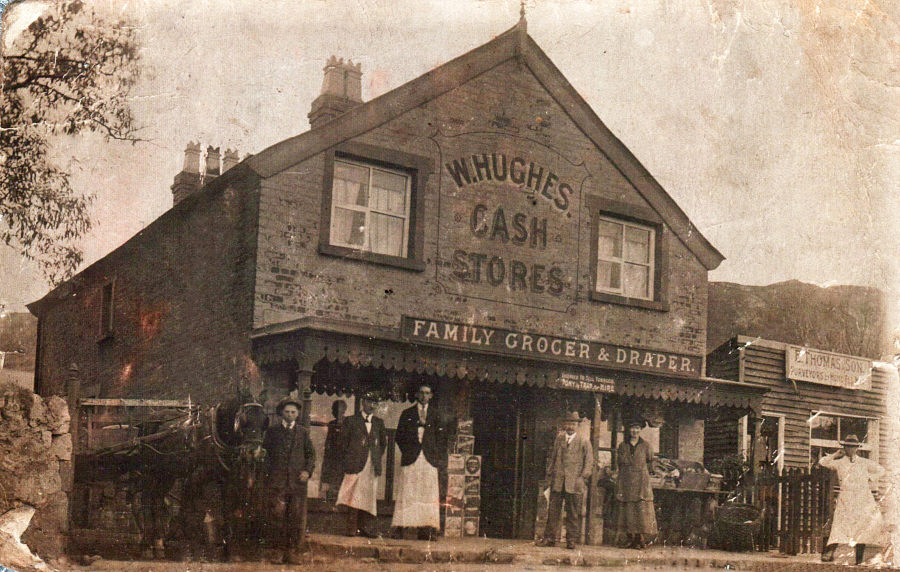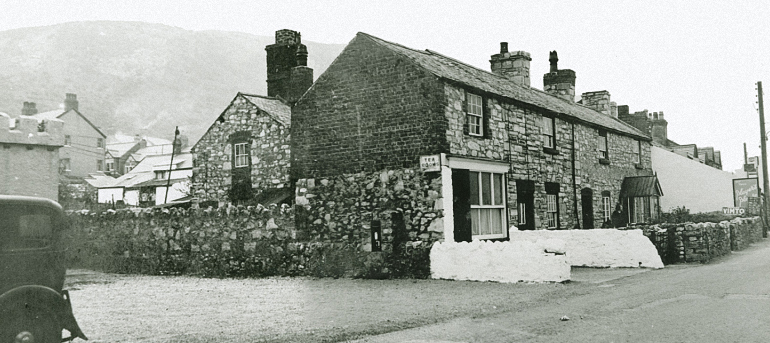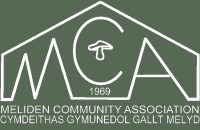The Shops
In the 1960s Meliden still had a good selection of shops. The Post Office was in Mostyn House Stores, opposite the old school and Phyllis Hughes was sub-post mistress. It was a long shop with creaking wooden floorboards and well-worn wooden counters—nothing was level, straight or even. The Post Office counter was along the right side with a short open section and then a wooden panelled partition covered in notices right up to the ceiling. Phyllis used her Post Office stamp with great energy and the part of the counter she favoured had a pronounced dip from many years of use. On pension day, the stamping could be heard from the school playground! Behind the counter on the other side were galvanised buckets, mops, assorted household goods and shelves with jars of sweets, jars of jam, packets of tea, boxes of Smith’s crisps and loose biscuits which you could buy by weight. She did a good trade because she sold small quantities and people who lived by themselves could even buy half-packs of some items. She kept certain things like the National Savings Certificates somewhere secret and if you wanted to invest in one, she would disappear down the steps at the far end and then after the sound of several locks being opened, there would be a lengthy silence before the whole procedure was heard in reverse. Children used to slither over the wall next to the telephone box to buy their sweets and the top of the wall became quite shiny. Older children would race over at the end of morning and afternoon schools to ask if there were any telegrams to be delivered. If you were the chosen one, you earned sixpence or even a shilling if it was up the Bryniau. She was very fair—there were no favourites and even girls were allowed.

Her father used to own the Cash Stores which was a Family Grocer & Draper [see the picture above], recognisable now as the One Stop Shop opposite the Park. At first I thought the gentleman wearing a hat in the centre might have been William Hughes but the age is all wrong because he died in 1923 aged only 44. Could that be Phyllis on the right? Her mother, Hannah Jane, who died in 1948, had been the village sub-postmistress before Phyllis took over. When she retired in 1979, there were over 200 at her presentation evening in the Community Centre. She died in 1994 aged 79. There were three brothers, Herbert, Trevor and Leonard.
After the Hugheses moved down to Mostyn House, their shop became Lodwick’s, with all the vegetables on one side of the shop and the meat and cheese on the other—there may have been goods outside too. Lodwick’s had a smell of its own—coffee, kippers, vegetables, herbs & spices, cheese, vinegar, wax polish and more. A red bacon slicer was surrounded by piles of ready-sliced cold meats waiting under glass bell-jars. The corned beef was 1/3d. a quarter—I remember the price because when you gave him half-a-crown, he would slap the change on the counter and say, “One-and-three for me and one-and-three for thee!”
To the left of Lodwick’s was a little flat-roofed extension that you can still see but its window used to be full of cakes and bread! It was run by the Miss Davies and Miss Saunders. You don’t see cake shops like that now because fancy cake production is so time consuming, hence the two-day-old factory made products we have become accustomed to, even from the posh supermarkets. They sold tube-shaped rasp loaves—great fun to cut and spread but people started preferring ready-sliced bread made in a factory. Oh for a freshly made Chelsea bun!
Bill Hughes the Butcher was in the house next to Mount Pleasant before he moved over the road to take over Lodwick’s old shop. When did you last see a meat wagon with the driver carrying in whole carcasses on his shoulder? Cathy set up her hairdressing salon in the old butcher’s afterwards. Between the old butcher’s shop and Mount Pleasant was a little rickety wooden shack supported on stilts which was Mrs Charlesworth’s antique and bric a brac emporium, filled with fascinating things, mostly on the floor. It was a shame to wake her up as she dozed in the sunshine—in her floppy hat and fur coat. She was guarded by a little pug with a black tongue that scared the living daylights out of children! Mrs. Charlesworth had taken over the shack from a cobbler who was a St. Melyd’s church warden.
Back on the other side of the road, the wooden building to the right of Hughes’s Cash Stores in the picture was Ted Thomas the butcher before becoming Miss Robinson’s Meliden Bazaar but I only remember it as Anderson and Gardiner’s electrical shop. Apart from doing the usual household electrics and electrical repairs, they rented out television sets. Not a Sony or a Samsung in sight but the old names like Ecko, Philco, Bush, G.E.C., Ferguson and Grundig. Many of the people of Meliden rented their first television set from here before companies like Telefusion and Manweb arrived in Prestatyn to lure away customers with enormous 18 inch colour sets.
Built onto the front of the disused Wesleyan chapel to the left of the park were two lock-up shops—Crompton’s on the left and Parry’s on the right. Gwilym Parry had once worked over the road in Lodwick’s before setting up for himself. The Parries’ shop always smelled of vinegar because people went with empty bottles and Gwilym would fill them using an old-fashioned tin funnel and measuring jug. Not a plastic bag in sight and no pre-packed goods—everything was loose and weighed on balance scales before being placed in brown paper bags. Mrs. Crompton always had a large number of children with pennies in their pockets passing her shop on the way to school each morning. She stocked more trendy sweets than Phyllis Hughes—the sort that were being advertised on Granada TV since the rationing ended in 1953. There were sherbets shaped like flying saucers, yellow sherbet fountains with a liquorice straw sticking out, black jacks, bootlaces, sweet tobacco—she even sold complete children’s Smoking Sets! Imagine the trying to do that now! Spangles, aniseed balls, gobstoppers and little sweets with messages written on them, white mice and chewing gum in so many varieties that they had a special display of their own. The more affluent with strong jaws could buy McCowan’s Highland Toffee with the picture of the cow on the front for 3d. It was so hard on a winter’s morning that it was necessary to bash it against the park railings to crack it before opening the wrapper. Mrs. Crompton was always well prepared for October, which was the start of the firework-buying season—that definitely would not be allowed now! Bangers, Catherine Wheels, Jumping Jacks, Vesuvius and Roman Candles all mixed up with yarns of wool, reels of cotton and knitting needles that looked like sparklers. It was exciting.

On the other side of the road after the Star Inn came the row of houses known as “The Shops.” [See the picture above] First was Harry Davies who sold wet fish during the day and fish and chips at night—I think it became Cathy’s hairdressing salon after she left the old butcher’s. Do I remember a shoe shop somewhere around there? It was a great surprise when it became a Chinese takeaway—in Meliden—who would have believed it? Next-but-two was a newsagent and sweetshop—John Steele and then Mr. Black and Mr. Williams—later still, J. Cauley—the only shop apart from the Post Office [for newspapers] that opened on a Sunday between 10 and 12 but only certain things were allowed to be sold. Then came the Cavanahs’ two shops, the wool shop and the grocery store. In the early 1960s the grocery shop had a big counter that ran across the back—with shelves behind where everything was stacked but you couldn’t get near it. Suddenly, the shop closed and a couple of days later there was a new shop called V.G. Stores. The rear interior walls had been knocked down and the shop seemed to go on for ever with shelves everywhere. You could wander around and look at the tins and packets and even lift them up—although most people were reluctant at first. Everything had little sticky price labels and Sam patiently explained about the wire baskets and how you just went around in your own time, “No need to hurry—just pay at the till—but don’t take the basket home!” There was a freezer there, only about the same size a present-day home chest freezer and it had inside something rarely seen in Meliden before—Fish Fingers! Whole meals on foil trays were sold ready for the oven—no microwaves in those days and the packets of peas were small because you had nowhere at home to keep them longer than about three days even if you were one of the few who had a fridge. Sam didn’t work the till because he was a man and it was the 1960s, instead he dressed in an immaculate white coat and acted like a master of ceremonies. He operated the bacon slicer and was it was fascinating to watch the slices just falling away from the joint as the big blade it did its work. After the alterations, it was possible to walk through into his wife’s wool shop next door. Do I remember trading stamps?— Green Shield or something similar. Self service proved to be popular so Sam bought a Jaguar and smoked big cigars.
The end shop, next to the passage was John Clayton’s Seafield Stores, which mostly sold sweets and tobacco but he must have sold ice cream because there was a metal Lyons Maid Ice Cream sign outside. It became Walters’ Bakery where the cream doughnuts had special nets placed over them to stop them floating away. His floury looking bread had a yeastiness that made it unique—he was what we would call an artisan baker but that was normal in those days and he was taken for granted. Any bakery offering that sort of thing now would cause a sensation and even more traffic chaos.
Finally, out by themselves, were Arthur and Hilda Sykes in their ex-War Department wooden hut. Before they took over, it had been Hughes’s Bread Shop with ovens around the back. Mrs Sykes always kept it warm and smelly with an Aladdin paraffin heater. Her stock of hardware was incredible—I won’t even try to describe it—but I am sure we all recall the obstacle course between the door and the counter. That was only the tip of the iceberg because around the back, behind an enormous tank of paraffin—which would never be allowed now—was the old bake house full of planed timber and all sorts of building materials. Arthur died in sad circumstances in 1958 but she carried on the business. She knew what people wanted and with the new estate over the road, she never lacked for customers. Valour, Tilly and Aladdin heaters were still very common and she was the only source of paraffin in the village. Rather like Phyllis Hughes at the other end of the village, Hilda Sykes knew everybody’s business but there was a difference—Miss Hughes listened, Miss Sykes interrogated! My mother used to say, “Whatever you do, don’t tell Mrs. Sykes!”
